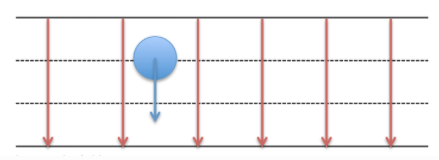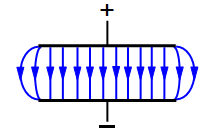If you can do gravity, you can do electrostatics. They are both inverse square laws for non-uniform fields and behave similarly for uniform fields too.
Remember this diagram? This time, imagine two parallel metal plates – very large, separated by a few mm in air. A primitive capacitor, in other words. The top plate is positively charged by connecting it to the + terminal of a battery and electrons from earth will be attracted to the bottom plate. Because the charges are all of the same kind on each plate and the surfaces are flat, they spread out as far as they can, like a carpet. Now, imagine a charge of say +3mC (in blue) somewhere in between the plates. It’s experiencing a downward force, repelled by the top plate and attracted to the bottom one. This is quite a large blob of charge, since an electron has a charge of 1.6 x 10-19C.
Why is the force always vertically down (or up, depending on polarity)?

If we imagine our carpet of charges, and the charged particle in between them, each + charge exerts a repulsive F on the test charge in the middle. Each – charge on the bottom exerts an attractive F along the same line, as the diagram shows. Each + is paired with a – in other words. Taking two at random the resultant F is seen to always act downwards, and is the same size, wherever we are in between the plates. There is a uniform electric field between the plates in the same direction as the force on the charge. An electric field is a region where charges experience an electric force. Numerically, it is the force per unit charge, so we can write:
E is a vector because F is a vector. We now see that the red lines on the diagram show the direction of E. They are uniformly spaced since the field is uniform, in other words, the field is everywhere the same.
Let’s put some numbers on our original diagram. The dotted lines are lines of equal potential, or equipotential lines (or surfaces). We have to do electrical work on a + charge to climb up from one equipotential to the next, just like we have to do mechanical work against a gravitational field.
The p.d between each equipotential is 5V in each case and let’s suppose that the plates are 6mm apart ( not shown on the diagram).
Now, watch this. We know that a volt is a joule per coulomb. Also, (electrical) work done = force in N x distance in m. So, we can write that:
So, the uniform electric field between two parallel plates can be written down as:
In our example above, and being careful about units, E = V/d = 15/0.006 = 2500V/m. On a charge of 3mC, the electric force F between the plates is Eq = 2500 x 0.003 = 7.5N
Edge effects. IB asks this, A level doesn’t. At the edges of the plates there are no more partners for the charge in the middle to pair up with , so the field lines curl outwards. Be careful, if you’re asked for this diagram, it has to be tidy, with clear, non-overlapping, non-dotted lines WITH ARROWS, starting and finishing at a plate, like this.







Reblogged this on John Vagabond's Physics and Chemistry Blog.